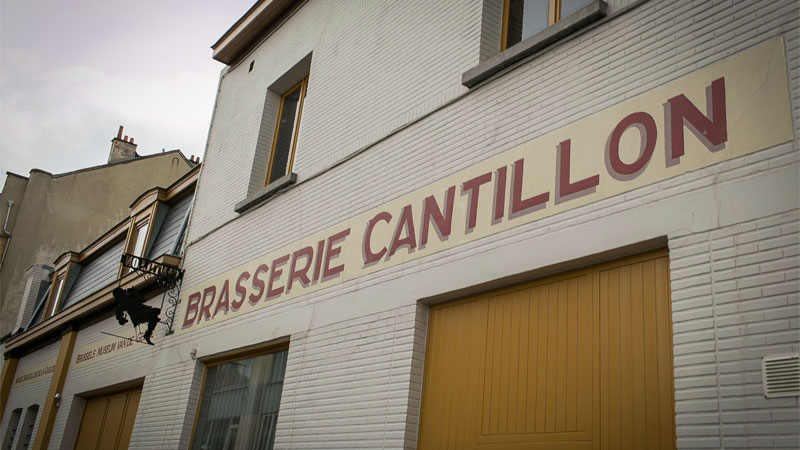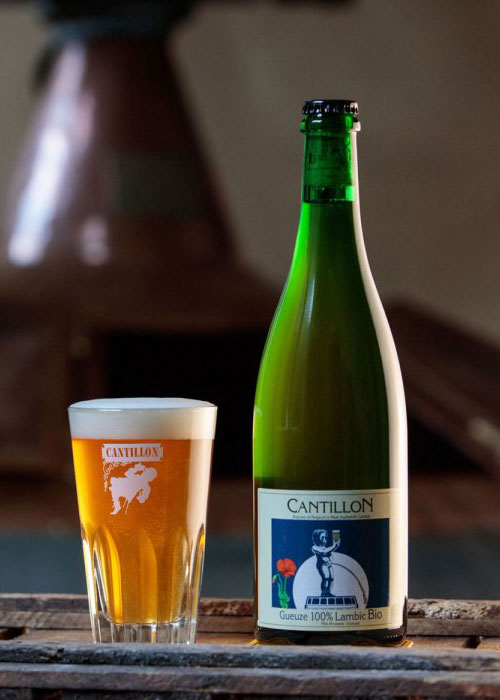The recipe for the tête pressée, or head cheese, calls for half a pork head, two hams, two pork feet, celery, leeks, turnips, carrots, onions, and assortment of herbs and spices. This all soaks in a pot overnight, is then boiled, before two entire bottles of Cantillon Gueuze are added. This is not some ostentatious troll dish meant to anger beer geeks and garner TikTok views, but rather a recipe from 1995’s “La Gueuze Gourmande,” a cookbook strictly devoted to dishes made using Cantillon beers.
“It never struck me as sacrilegious,” Nicole Darchambeau, the book’s author, tells me. Most all others would disagree. In fact, if I can make an analogy to drive the point home about how insane this feels, it would be like if there were a “Cooking With Pappy Van Winkle” cookbook released just a decade ago.
You see, there’s no international brewery celebrated more by Americans than Brasserie Cantillon, whose lambics and gueuzes are hoarded by collectors, fetch big prices when scant bottles appear at retail shops and in bars throughout the country, and even necessitate a worldwide celebration, Zwanze Day, every September, with events held in U.S. cities spanning from Tacoma, Wash., to Worcester, Mass.
But it wasn’t always that way. As recently as the 1990s, few had even heard about Cantillon in America and no one really cared about it in its homeland of Belgium, where the brewery had only about 20 retail and bar accounts. So disregarded was Cantillon at the time, that indeed it wasn’t sacrilege for “La Gueuze Gourmande” to encourage at-home chefs to literally cook with its beers, offering 108 different recipes.
Today, the book has been mostly forgotten because, well, no one in their right mind would ever waste precious ounces of Cantillon on moules frites or beef carbonnade. Yet, “La Gueuze Gourmande” remains a remarkable artifact, a look at a time in the recent past when virtually no Americans knew what sour beer was, when there was certainly no such thing as widely hyped beers and a black market to buy and sell them, and a few ahead-of-their-time people simply wanted to enjoy some Cantillon.
“I savor it moderately, as a connoisseur, but it flows freely in my pots,” writes Darchambeau, in French, in the book’s introduction. (I tried my best to translate an e-book I was able to acquire.) “What discoveries in the land of flavors!”

One day in the early 1990s, while drinking at Cantillon’s Museum of Gueuze in Brussels, Darchambeau decided the brewery and its intriguing lambic beers merited a book. At the time, she was cooking daily with beer, inspired by the work of Belgian master chef Raoul Morleghem, who codified the concept of la cuisine à la bière in the 1950s. Darchambeau was a fairly new cookbook author back then, too, having previously been a tapestry maker, before writing “La Bière, Ca Se Mange!” (“Beer Can Be Eaten!”) in 1994. Publishers weren’t interested in her manuscript so she formed her own publishing house, Editions Les Capucines.
Cantillon was likewise being taken a bit lightly at the time.
Founded in 1900 by Paul and Marie Troch Cantillon in an industrial part of southern Brussels, near a train station, initially Cantillon was simply a beer merchant of sorts. Back then, they didn’t actually brew beer, instead sourcing the spontaneously fermented lambic from a variety of other producers and then blending it and sometimes adding fruits (a common practice, even today).
By 1937 Cantillon was brewing its own beer but both World War II and a lack of interest in traditional lambic made business tough — locals were gravitating toward the artificially sweetened beers made by the major local brewing groups Artois-Jupiler and Alken-Maes, something even Cantillon tried for a time before completely spurning it. A man named Jean-Pierre Van Roy would eventually marry Paul Cantillon’s granddaughter and by 1970 he was running the show at Cantillon.
“[Y]et the consumption of traditional Gueuze had already been declining for the past 10 years,” Van Roy writes in the forward to “La Gueuze Gourmande,” noting that he initially didn’t appreciate the honor of having an entire recipe book written based on his brewery’s beers. He was well aware that many notable beer books over the years had been sponsored by breweries and, thus, in his opinion, “contain very little truth.”
He wanted to make clear that this was not the case in the pages that follow, writing: “The author highlights that the acid taste works wonders in cooking whereas, in the name of consumption, the food industry wants to impose easy tastes on us, the sweet and the salty, and wipe the bitter and the sour from our palates. What a danger!”
Van Roy doesn’t offer any recipes himself, but discusses frequently taking a “tonic” of egg yolk, sugar, and gueuze to cure fatigue, something recommended by his father-in-law Marcel Cantillon. He sadly notes the lack of interest in Cantillon as the 20th century draws to a close, explaining that “very few [friends] drink my Gueuze regularly. Beer consumers are drawn to questionable or deceptive advertisements and also to easy tastes dominated by sugar.”
Maybe that’s why he was so amenable to helping out with a cookbook that truly highlighted the beauty of Cantillon. Anything that might help sell his obscure, Old-World, funky beers, which featured a wild yeast few writers were waxing poetically about in 1995.
“The Brettanomyces, these friendly yeasts, assailed me, then inspired me before invading my dishes,” writes Darchambeau. She believed its presence in her dishes could take them to a higher place (“subliment la gastronomie!”), while offering a variety of flavors and complexities you simply couldn’t get from traditionally prepared dishes.
The recipes are well organized, starting from the simple and then increasingly moving to the more baroque. There are soups, sauces, jams, and confit. There’s an oyster pie and a fondue.
There is terrine and a variety of charcuterie, and sliced pork kidneys cooked with pears. There are desserts like sabayon, pudding, and ice cream. They are lavish entrees of every category.
There are — not surprisingly — a number of moules à la gueuze, the quintessential Belgian dish of mussels steamed in a gueuze broth, served with watercress or potatoes. There are other seafood dishes that are less expected. Salmon with leeks and mushroom covered with gueuze and cooked in a microwave (this was the 1990s, remember). Bavarian tuna with goat cheese, Bavarois de thon au chèvre, a cold dish served on a bed of gueuze gelatin. There’s likewise Anguilles au vert, a casserole dish of seared eels and vegetables covered with a sauce of cream and Cantillon Gueuze.
Even today Cantillon Gueuze, sometimes known today as Organic Gueuze or Gueuze 100% Lambic, is the most produced Cantillon product and by far the easiest bottle to find. But, it still ranks as a top 250 beer in the world, according to Beer Advocate, and 750 milliliter bottles regularly go for $50 to $75 if you’re lucky enough to find one in the States.

But, it wasn’t just standard Cantillon Gueuze being used in Darchambeau’s recipes. She offers a soup prepared with Cantillon Faro, a sugar-sweetened cask beer exclusive to Belgium. There is an onion jam made with Cantillon Kriek, a sour cherry lambic (Confiture d’oignons à la Kriek). There is also a lamb liver prepared with Rosé de Gambrinus, a raspberry lambic, and Foie de bœuf à la Vigneronne, beef liver roasted in Cantillon’s muscat grape lambic. Even in 1995, this couldn’t have been a cheap cookbook to recipe test for, although Darchambeau tells me she then got her bottles at Delhaize, the supermarket chain known as Food Lion in the U.S.
“La Gueuze Gourmande” would be sold at select gift shops around Belgium, including Cantillon’s own, though many would-be readers acquired copies by simply writing to Darchambeau. It sold 1,500 copies, a big number for a niche Belgian cookbook at the time. It was popular enough to necessitate a second edition in 2006 and even a sequel, “Le Temps des Cerises Chez Cantillon,” focused exclusively on Cantillon Kriek recipes, which followed in 1999.
Meanwhile, Cantillon’s reputation was greatly burnished over the years, and Darchambeau’s book bolstered beer sales in Switzerland, the Netherlands, and Italy, in particular. Meanwhile, bottles were becoming harder and harder to find in the U.S. as the 2010s approached, this rising fervor being rewarded by the creation of Zwanze Day in 2011.
“Is such a business still profitable?” Jean-Pierre Van Roy claimed many visitors asked him upon touring Cantillon’s facilities in 1995.
It barely was back then. In the last decade, however, the company has expanded to a second facility with more than double the production capacity. Jean-Pierre’s son Jean Van Roy is now the brewmaster, a cult figure for the brand who tours the globe and is the toast of beer geeks the world over. By 2017, when Cantillon released that season’s bottles of Fou’Foune, Nath, and Lou Pepe Framboise, the brewery had an onslaught of fans and the entire year’s run sold out in a couple hours. Bottles were soon selling for hundreds of dollars on the secondary market.
Today, la cuisine à la bière has become a bit of a rarity in Brussels, but it certainly does exist, though, as Jean Van Roy told The New York Times in 2014, “Most restaurateurs are very discreet with [beer] as an ingredient.”
Not at Nüetnigenough (“never, ever enough”) near the Grand Palace, however, which uses beer in pretty much all its dishes, though often employing more readily available local brews. Like Hanssens Raspberry Lambic, which is used to make a Bloempach, Brussels black pudding. A rabbit with prunes is cooked in Duvel. The restaurant’s chicken cream stew is prepared with mushrooms and Saison Dupont. Yet, even today, Nüetnigenough serves a flank steak with shallots and a Cantillon Kriek sauce. It is, no surprise, the priciest entree on the menu.
Darchambeau would likewise visit additional breweries’ beer via cookbooks, penning over 600 recipes in the ensuing two decades highlighting beers such Orval (Saveurs d’Orval), Saison de Silly (Délices de la brasserie de Silly), Chimay (Chimay une cuisine festive), and the monk-made Rochefort (Les Trappistes de Rochefort), published as recently as 2006. She found some beers work better in food than others.
“For example, for the Orval, a bitter beer, it is not always easy to cook because you have to calculate,” Darchambeau told a Belgian beer blog in 2008. “On the other hand, there are fewer difficulties with a Chimay or a Rochefort.”
Those are all beloved Belgian classics, able to be found with little difficulty at most grocery stores in the U.S., but none are as revered or rare as Cantillon. Today, people wouldn’t bat an eye if you prepared a dish using Orval, Chimay, or Rochefort. But, were you to cook with Cantillon in 2020, you wouldn’t seem like a “gourmande,” but rather a profligate troll.
Unless you’re Darchambeau, that is.
“I continue, far and wide, to use Cantillon products in the kitchen,” she admits. “I understand, of course, that given the price of a bottle of Cantillon Gueuze across the Atlantic, the amateur [chef] prefers to drink it rather than incorporate it into a dish.”
